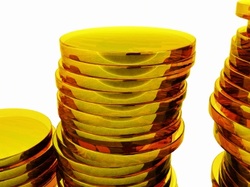Don’t Be Fooled By Fake Gold or Silver Coins Gold and silver coins are wise investment options as the value of these precious metals can increase over time. Moreover, their value does not easily depreciate, unlike currencies and stocks, whenever there are global issues that influence the international market. So, investing in gold and silver coins will help in balancing out one's portfolio. These metals can adequately pad one's losses in case the prices of stocks or currencies fall. Because precious metals offer better stability to investors' portfolios, most experts or analysts even recommend for investors to allot about 15% of their investments on precious metals. For gold and silver coin collectors and investors, one concern is regarding the pervasive presence of fake items. So, it's really a must for anyone who wants to invest or collect gold or silver coins to be able to tell if a coin is fake or real. There are counterfeit coins out there that can easily fool those who are new to investing or coin collecting. For those who are planning to purchase or invest in gold or silver coins, here are two parameters to evaluate in order to tell if coins are fake or real. 1. Weight There are many types of gold and silver coins sold as bullion pieces. These coins have specific weight. For instance, the popular American Eagle bullion coin is available in 1 ounce, half, quarter and a tenth of an ounce. There are also 2-ounce bullion coins, such as the Australian Dragon (gold). The weight of a coin must be exact - not too light or not too heavy. Fake silver coins are lighter than the real ones because of the fake silvery metal alloy used. If a coin is too heavy, then the plating used may be lead. If a precision weighing scale is available, it's also a good idea to weigh a bullion coin. Bullion coins are weighed in troy ounces, wherein 1 troy ounce is equivalent to 31.10 grams. A troy ounce is different from an avoirdupois and imperial ounce. When there is a real coin available, use this as a reference. Weigh the real coin and compare the weight of the coin that is being evaluated. Just make sure that both coins are of the same type. 2. Appearance Place a real coin beside the coin being assessed. Check the edges and decorative elements. If a coin displays some smudges or minor dissimilarities from the real coin, then it's probably a fake. When looking at the edges, real coins will have uniform thinness and even edges all around. On the other hand, fake ones may display bumps or have no edges at all. Check the reeding or the parallel grooves on the edge of a coin. Some coins have reeding or milling on the edges while others don't. Hence, it's best to check if the coin in question should have reeding or not. If the edge has reeding when there shouldn't be, or vice versa, then it must be a fake. The lettering, designs, and other decorative elements must be examined closely. Disparities in thickness, presence of smudges or fuzziness in the designs or letters mean that a coin is probably a counterfeit. The information or details on a coin should also be checked to see if there are discrepancies. Citations:The article is by Claire Kingsley. She is a freelance writer who specializes in coin collecting. Kingsley blogs for many respected gold coin dealers, and she also regularly writes about United's Rare Coins.
0 Comments
Leave a Reply. |
About Me
I'm Louida from Atlanta, Georgia and I'm a mother of two daughters, and a full-time blogger/influencer.
I love helping others learn how to start working from home online free to help supplement their current income. I also blog at Productreviewmom.com Subscribe to newsletter
Google+
Pinterest
Grab my Badge
 SponsorsCategories
All
Archives
March 2020
Sponsors
|
ABOUT LOUHey! I'm Louida (Lou-why-da) Martin, but I like to go by Lou for short.
I was born and raised in Northern California, and now reside in Greater Atlanta, Georgia area with my two teen girls and high school sweetheart. I created this blog to show people that there are ways to make money online free. No need to take on a second job. |
QUICK LINKS |
© 2008 - 2018 LM Marketing, LLC - All Rights Reserved - Web Design by Debbie Navarro Disclosure Policy - Privacy Policy |
Disclosure : EarningFreeMoney.com earns income through affiliate marketing programs, it does not affect the views of this content. Results may vary on how much you make with programs advertised on this blog.



